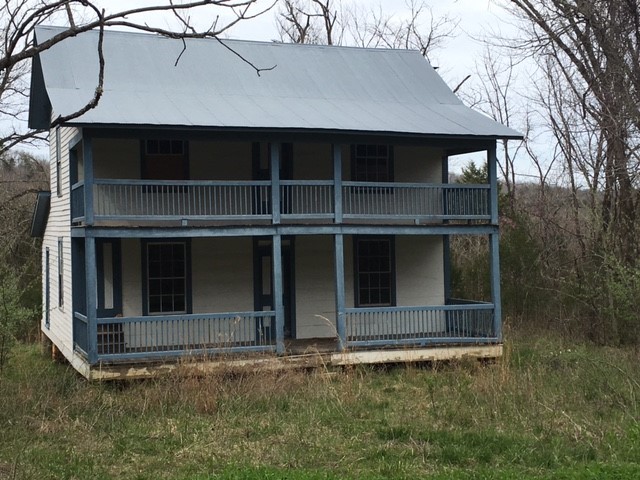Chilton-Williams Farm Complex (Chilton Place)
Introduction
Text-to-speech Audio
The Chilton-Williams Farm Complex represents the growth of an Ozark farm from the years following the Civil War to the late twentieth century. The Chilton family constructed the first buildings, but subsequent families added many throughout the twentieth century. The historic Chilton House, one of the oldest buildings in Shannon County and the only surviving specimen of this style left in the area, was built sometime between 1869 and 1879. The complex, with its fifteen surviving structures, stands today as a representation of more than a century of changes in agriculture and rural architecture. The complex also speaks to the history of the Chilton family, who arrived at the Current River valley during the early nineteenth century, mostly from Tennessee.
Images
Chilton-Williams Farm Complex

Backstory and Context
Text-to-speech Audio
The Current River flows southward through the south-central Missouri Ozarks, marked by its forested mountains and narrow river valleys. Underground springs, more than surface runoff, provide most of the water that flows through the nearby rivers, allowing for generally clear water. Although initially home to Native Americans, the attractive landscape inspired white settlers to move into the region, notably farmers from Tennessee and Kentucky, many of whom brought slaves with them. The white settlers established small farms where they primarily grew corn, hay, and wheat. The unique topography confined farms to narrow valleys beside the streams, resulting in a series of isolated farms separated by hills and mountains.
The origins of the Chilton-Williams Farm Complex begin in 1816 with a family from Tennessee settling in the southern Missouri Ozarks. Thomas Boggs, son of a Welsh immigrant, was born in Maryland in 1782 and then moved to Tennessee in 1816. He and his wife, Susan Chilton, migrated to the Current River valley with several children that same year. In fact, nearly two dozen Chilton families moved to the Current River Valley in the early nineteenth century. Many of them succeeded in commercial agriculture, opened businesses, and became active in local politics; thus, they evolved into some of the area's first "elites." Meanwhile, Thomas and Susan gave birth to their youngest child, Francis (Frank), in 1827; he married Margaret Fancher Stearman in 1845, and the couple went on to have five children. In 1859, Frank Chilton obtained a nearly 190-acre land grant located on the west bank of the Current River in Shannon County, which now survives as the Chilton-Williams Farm Complex.
Frank and Margaret's property sat in a wide valley formed by a horseshoe bend in the river. Either Francis Chilton or his sons built a house on the property sometime between the late 1860s and 1880. And then several additions were added throughout the first decade of the 1900s. Although records and family traditions are ambiguous about its original construction date, it is clear that the home's siding was cut at a sawmill located at the conjunction of the Current River and Jack's Fork. After cutting the wood, they floated it down the river to the house site, where builders planed it by hand. Frank died around 1870, but Margaret managed the farm and raised their children. In 1894, after Margaret's death, the farm passed into the hands of her three surviving children before the family sold and divided the land in 1912.
Jeff Davis Williams and his brother, C.L. Williams, purchased two of the divided sections. Jeff bought the lower or downstream farm while C.L. bought the upper farm, including the Chilton homestead. Jeff Davis built a small general store at the junction of the road to Powder Mill near his home in 1912; he operated it together with the lower farm. C.L. traded the property to a third Williams rother, Clinton H, in 1918. Clinton Williams served as Presiding Judge of Shannon County Court (an administrative, not a judicial position) from 1924 to 1926. He was also appointed Postmaster in 1923. He established the post office in a small building directly opposite the house and named it "Owl's Bend Post Office" because of the many owls in the area.
In 1918, the same year that C.L. Williams traded his upper farm to his brother Clinton, Jeff Davis sold his lower farm to W.T. ("Bud") Knuckles. From 1918 to 1940, the Williams family lived on the upper farm, while the Knuckles family lived on the southern farm. In 1940, Lillian B. Baltz bought both farms, effectively re-consolidating the Chilton property. She also moved the post office to an addition that had been added to the house in 1937 on the lower farm. Finally, in 1967, the U.S. Government acquired the land as part of the Ozarks National Scenic Riverways.
Today, the historic Chilton-Williams Farm Complex, or Chilton Place, includes fifteen contributing buildings and two additional contributing structures, all associated with a post-Civil War Ozark farm. Structures include the Chilton House and Williams-Baltz House, several barns, a smokehouse, and various farm buildings.
Sources
Ozark Radio News Staff. "Ozark Riverways to host Chilton House reunion on October 28." Ozark Marketing. October 22, 2017. https://www.ozarkradionews.com/local-news/ozark-riverways-to-host-chilton-house-reunion-on-october-28.
Perry, Milton F. "Nomination Form: Chilton-Williams Farm Complex." National Register of Historic Places. mostateparks.com. 1981. https://mostateparks.com/sites/mostateparks/files/Chilton-Williams%20Farm%20Complex.pdf.
Stevens, Donald L. 1991. A Homeland and a Hinterland: the Current and Jacks Fork Riverways. A Historic Resource Study: Ozark National Scenic Riverways. Omaha: National Park Service, Midwest Region, 1991. A free, digital version of the book is available at https://www.nps.gov/parkhistory/online_books/ozar/hrst.htm.
https://www.ozarkradionews.com/local-news/ozark-riverways-to-host-chilton-house-reunion-on-october-28
